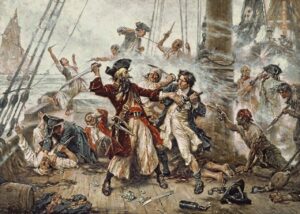Piracy during the mid to late 17th century is often referred to as the ‘Golden Age of Piracy’. This Age encompassed three notable outbursts of pirate activity, during which piracy flourished and dominated the seas. The third outburst of the Golden Age occurred after the European nations signed peace treaties ending the Wars of Spanish Succession. This peace left thousands of sailors and privateers without work, facilitating their turn to piracy. One of the most notable and infamous pirates on record came from the third phase of the Golden Age of piracy. His common name was Edward Teach (or Thatch); however, most know him as Blackbeard.
Historians estimate that Edward Teach was born around 1680 in Britain. His early life is largely unknown since his birth name remains obscured in the historical record. Pirates and outlaws tended to operated under falsified names in order to protect their families from a tainted reputation. Edward Teach pops up again in 1702 as a British privateer out of Jamaica during Queen Anne’s War. Privateering was essentially legal piracy; privateers had permission from Britain to take French and Spanish ships and keep a percentage of what they found. Once the war ended in 1713, Teach found himself out of work and joined with Benjamin Hornigold’s pirate crew in New Providence and began his notorious career.
New Providence was a proprietary colony, meaning it was not directly under the king’s control, allowing the pirates to enjoy the rum and women in its waterfront taverns without regard for the law. Like other pirates, they followed a migratory routine. In the spring they would head north in their maneuverable sloops and harass merchant ships, laden with cocoa, cordwood, sugar and rum along the Delaware Capes or the lower Chesapeake. In the fall, they sailed back south to the islands. Hornigold and Teach were seen in October 1717 off the Delaware Capes; the following month they captured a ship near St. Vincent in the Caribbean. After the battle, Teach claimed the ship and renamed her The Queen Anne’s Revenge. She became Teach’s flag ship for his infamous pirate fleet and he became a wild success, taking some 25 prizes.
In 1718, Teach moved his operation to Charleston and proceeded to blockade its port. He terrorized and plundered any ships that arrived there. Teach moved his pirate fleet towards North Carolina when he heard of the possibility of pardon and the possibility to avoid the clutches of the British men-of-war sent to quash Britain’s pirate problem. There he provoked the wrath of the Pennsylvania Governor Alexander Spotswood, who ruthlessly interrogated one of Teach’s former quartermasters and obtained the vital information of Teach’s whereabouts. The Governor sent Lieutenant Maynard with several poorly armed ships to capture Teach, resulting in a battle that would end in his death. Much confusion surrounded the accounts of this last battle at Ocracoke, but Maynard’s own account reveals that it took 5 gunshot wounds and 20 cuts to finally kill Blackbeard. Maynard claims that Blackbeard “At our first Salutation, he drank Damnation to me and my Men, whom he stil’d Cowardly Puppies, saying, He would neither give nor take Quarter”.
Blackbeard, was said to frighten his opponents just by looking at them. To add to the intrigue and fear, Blackbeard was rumored to have woven gunpowder-laced wicks into his beard and lit them when he went into battle. The description of this “demon from hell” look is partly corroborated by eyewitness accounts of the time, outdoes anything that Hollywood could invent: “…our Heroe, Captain Teach, assumed the Cognomen of Black-beard, from that large Quantity of Hair, which, like a frightful Meteor, covered his whole Face….This Beard was black, which he suffered to grow of an extravagant Length…he was accustomed to twist it with Ribbons, in small Tails…and turn them about his Ears: In Time of Action, he wore a Sling over his Shoulders, with three Brace of Pistols, hanging in Holsters like Bandaliers; and stuck lighted Matches under his Hat, which appearing on each Side of his Face, his Eyes naturally looking fierce and wild, made him altogether such a Figure, that Imagination cannot form an Idea of a Fury, from Hell, to look more frightful”. This combined with his well armed flag ship would strike fear into the heart of any man. Yet, many accounts complicate this famous image of a bloodthirsty pirate; in one account, Teach called a delegation of his prisoners into his own cabin on the Queen Anne’s Revenge. Calmly, he explained that they were taken off the ship so that the pirates could hold a “general council” to decide on their next move.
This type of behavior, in addition to provoking feelings of fear and terror among the ships’ crews he encountered, was seen as dangerous across the Atlantic. “Not only were the pirates taking property,” says Lindley Butler; “they were an affront to the hierarchical, class-based social structure in Britain. I think that burned them back in England as much as the property taking.” Pirates elected their captain, quartermaster and other ship’s officers; conducted “general consultations” on itinerary and strategy in which all members of the crew voted, and worked out an equitable division of prizes. This pirate code was written up in articles that each crew member signed upon joining the company. In addition, some pirate ships, perhaps including Teach’s, included Black men as members of the company. Pirate ships, unlike the Royal Navy, or any other government during the seventeenth century operated like democracies. This perversion of the class-based, rigid societal order of Britain at the time made the domination of piracy a dangerous threat.
Although Blackbeard’s legacy has been laid down in literature and film reproductions of his legend as a bloodthirsty pirate, many historical accounts complicate this view. In actuality, Edward Teach as Blackbeard was a complicated person of depth.
Back to Crime Library
|
|
|

